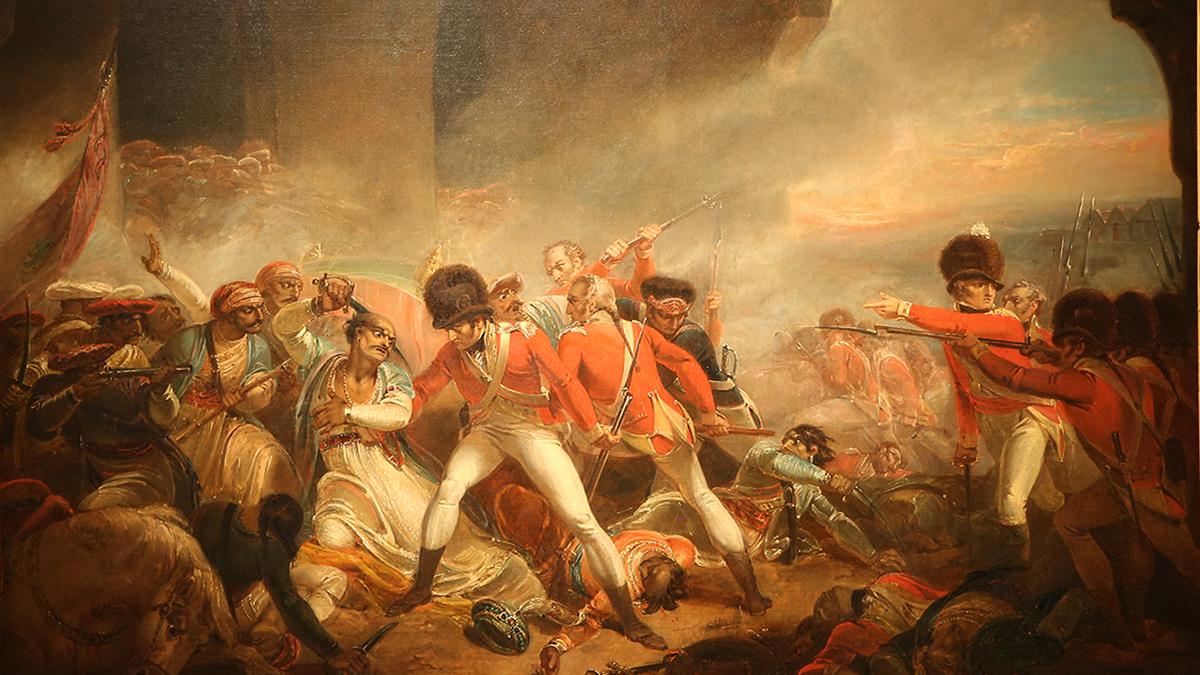Tipu Sultan: A Visual History of Resistance and Empire
History Indian HistoryPosted by NewAdmin on 2025-02-05 09:06:40 |
Share: Facebook | Twitter | Whatsapp | Linkedin Visits: 15

The Creation of a Historic Painting
In 1800, Henry Singleton created a striking painting titled The Last Effort and Fall of Tippoo Sultaun, a vivid portrayal of the Fourth Mysore War and the fall of Srirangapatna in 1799. Despite never having visited India, Singleton’s artwork is infused with vibrant, gem-like colors reminiscent of the Deccan landscape. The painting depicts a chaotic scene where British redcoats fire upon the Mysore Army, with Tipu Sultan heroically raising his sword, even as he faces death. This powerful image captures the tragic moment of Tipu's final stand against the British East India Company, an empire he fiercely opposed.
From England to India: A 200-Year Journey
For over 200 years, this painting remained in England, primarily displayed for a British audience. Its dramatic portrayal of Tipu Sultan’s death in battle was not just a historical representation but a symbol of British triumph over their long-standing adversary. However, the painting’s journey took a remarkable turn when it was acquired by the art company DAG, which specializes in preserving and promoting Indian art. DAG’s collaboration with leading art institutions allowed the work to return to India, where it now holds significant historical and cultural value.
Tipu Sultan as a Central Figure in Art
Singleton's painting is part of a broader collection featured in the exhibition titled Tipu Sultan: Image & Distance, which focuses on the visual history of the Anglo-Mysore Wars. The exhibition, which includes 92 works, examines the complex narrative surrounding Tipu Sultan, an iconic figure in India’s resistance against British colonial expansion. Through these artworks, the public narrative surrounding Tipu’s legacy has evolved, offering a nuanced perspective of his defiance, the portrayal of his defeat, and the lasting impact of these wars.
The Legacy of Tipu Sultan in Art and History
The return of Singleton’s painting to India serves as a reminder of the cultural dialogue between the East and West, particularly through the lens of colonial history. The artwork not only honors Tipu Sultan’s legacy but also provides a historical reflection of the British Empire’s dominance over India. Through exhibitions like Tipu Sultan: Image & Distance, modern audiences are invited to reassess the portrayal of this key figure, recognizing his role in shaping India’s resistance against imperialism.
Search
Categories
- Sports
- Business
- History
- Politics
- International
- Science & Technology
- Social Issues
- Disaster Management
- Current Affairs
- Education
- Startup Business
- Startup News
- Awards
- Community Services
- Fundraising Events
- Volunteer Services
- Health Initiatives
- Innovations and Initiatives
- In News
- dummybanners
- Awards
- Partners
- Products
- Press Releases
- News
- Fast Check
- South
- సినిమా
- Gallery
- Sunday Chronicle
- Hyderabad Chronicle
- లైఫ్ స్టైల్
- National
- క్రైం
- ట్రెండింగ్
- జాబ్స్
- అంతర్జాతీయo
- బిజినెస్
- రాజకీయం
- బిజినెస్
- సంపాదకీయం
- నవ్య
- చిత్ర జ్యోతి
- క్రీడలు
- జాతీయం
- తెలంగాణ
- తాజా వార్తలు
- మన పార్టీ
- మన నాయకత్వం
- మన విజయాలు
- డౌన్లోడ్స్
- మీడియా వనరులు
- కార్యకర్తలు
- North East Skill Center News
- Government Schemes
- Entrepreneurship Support
- Employment Opportunities
- Skill Training Programs
- Departments
- Investments
- Initiatives
- Resources
- Telangana IT Parks
- Events & Jobs
- Press Releases
- News
- Airport News
- Newtons Laws of Motion
- Karbonn in Business
- Investments in Karbonn
- Company quarterly sales
- Markets
- Auto News
- Industry
- Money
- Advertisements
- Stock target
- Company Updates
- Stock Market
- Company Sales
- Staffing and HR
- Constituency Assembly
- General News
- Srikalahasti Temple
- Bojjala Sudhir Reddy
- Technology & Innovation
- Sports
- Business
- Products
- Industries
- Services & Trainings
- Tools & Resources
- Technology Integration
- Drug Seizures & Arrests
- Telangana Narcotics
- Law & Enforcement
- Rehabilitation
- Nationwide Drug Policing
- Nigeria Seizures
- Global Operations
- Drug Awareness
- Drug Enforcement Tech
- NCB Drug Seizures
- Judicial Crackdown
- India's Surveillance Tools
- Cross-Border Links
- Women Safety
- Cyber Crimes
- Drug Abuse
- Traffic & Road Safety
- Community Connect
- Public Safety Alerts
- Citizen Assistance
- Nellore City News
- Politics & Administration
- Events & Festivals
- Agriculture & Rural
- Business & Economy
- Health & Wellness
Recent News
- Hurricane Erin Causes Beach Closures And Concerns For Coastal Communities
- Judge Frank Caprio Dies At 88, Shared Heartfelt Message Hours Before Passing
- Israel Strikes Hezbollah Targets In Southern Lebanon, Invokes 'Self-Defense'
- Mourners outraged by violent attack at funeral
- CM continues public hearings, says attack won't break her spirit
- Fix waterlogging in government-run schools: Minister urges officials for action
- Mourners condemn attacks at funeral of Brazilian councilwoman
- Philips i9000 Review: Premium shaving, reliable performance